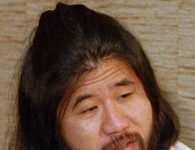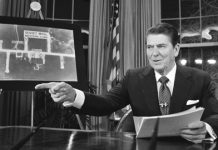On February 7, 1964, the Beatles were greeted by thousands of screaming fans as they landed at John F. Kennedy Airport in New York to begin their first American tour, highlighted by three performances on “The Ed Sullivan Show.”
The Beatles’ Arrival Marks Start of “British Invasion”
The Beatles, a group of four mop-topped Liverpool natives in their early 20s (John Lennon, Paul McCartney, George Harrison and Ringo Starr), had become Britain’s most popular rock and roll band in 1963, releasing hits such as “She Loves Me,” “I Want to Hold Your Hand” and “Can’t Buy Me Love.”
In August 1963, Ed Sullivan, host of the American variety show “The Ed Sullivan Show,” was delayed at London’s Heathrow Airport because of commotion caused by the Beatles’ arrival. He sought to book the group on his show, reaching a deal for them to headline three shows.
When the Beatles’ Pan Am Flight 101 touched down at Kennedy airport, they were greeted with throngs of shrieking fans, flashing lights and eager journalists. They held a press conference at the airport, answering questions with good-humored excitement.
The extravagant reception came as a surprise to the band members. “There were millions of kids at the airport, which nobody had expected,” recalled McCartney. “We heard about it mid-air…It was like a dream. The greatest fantasy ever.”
Related Content
Lennon remarked a few days after arriving, “We thought we’d have to grow everybody, and everybody seems to know us all as if we’ve been here for years. It’s great!”
On February 9, the Beatles performed on “Ed Sullivan,” which was watched by more than 73 million people, about 45 percent of the nation, according to Nielsen ratings. The group went on to play at Washington Coliseum and Carnegie Hall before returning to “Ed Sullivan” on February 16 in Miami and February 23 in New York.
The Beatles seemed to fill a void in America. John F. Kennedy had been assassinated just 77 days before the Beatles’ arrival, and as American Heritage writes, “American rock was at a nadir…The Beatles, with their driving rhythms and an edge honed in the ragged clubs of Hamburg and Liverpool, were bringing rock ‘n’ roll back to America.”
Video: The Beatles in America
Watch the Beatles’ arrival at JFK airport, filmed by Albert and David Maysles.
Watch the Beatles perform “I Want to Hold Your Hand” on their first “Ed Sullivan” appearance, and “All My Loving” on their second.
Sources in this Story
- CNN: When the Beatles hit America
- The Beatles Ultimate Experience: Beatles Press Conference, JFK Airport, American Arrival 2/7/64
- The Beatles: The Beatles Arrive on US Shores, 1964!
- Rolling Stone: The Beatles: Biography
- The Rock and Roll Hall of Fame: The Beatles
- Rolling Stone: The British Invasion: From the Beatles to the Stones, the Sixties Belonged to Britain
- Encyclopedia Britannica Online: The British Invasion
The Story of the Beatles
The Beatles began in 1960 as a five-man band featuring John Lennon, Paul McCartney and George Harrison on guitar, Stuart Sutcliffe on bass and Pete Best on drums. Lennon had met McCartney in 1957 and invited him into his band, the Quarrymen; the two met Harrison a year later and allowed him into the group.
The Beatles, originally the Silver Beetles, played most of their early concerts in Hamburg, Germany, and their home of Liverpool, England. Sutcliffe, who had little musical talent, left the band in 1960, leaving McCartney to take over on bass. Soon after the young musicians signed their first record deal in May 1962, they asked Best to leave the group; he was replaced on drums by fellow Liverpudlian Ringo Starr.
The Beatles had their first hit that October with “Love Me Do,” and their success continued in 1963. “By mid-year the Beatles were given billing over Roy Orbison on a national tour, and the hysterical outbreaks of Beatlemania had begun…Constantly mobbed by screaming fans, the Beatles required police protection almost any time they were seen in public,” writes Rolling Stone.
Soon after their American debut, the Beatles topped the American and British charts simultaneously with “Can’t Buy Me Love” and had the top five songs on Billboard’s Top Forty, a feat that has never been repeated. They released two movies, “A Hard Day’s Night” and Help,” while continuing to record and tour the world. In August 1965, they played in front of a record 55,600 fans at New York’s Shea Stadium.
The group ceased touring after an August 1966 concert in San Francisco to focus on recording in the studio. The result of their work was “Sgt. Pepper’s Lonely Hearts Club Band,” described by the Rock and Roll Hall of Fame as “an album that has almost universally been cited as the creative apotheosis of rock and roll, a watershed event in which rock became ‘serious art’ without losing its sense of humor.”
The group began to come apart in the late ‘60s, recording its final album, “Abbey Road,” in 1969. McCartney left the band in April 1970, and all four members soon began solo careers, marking the end of the Beatles as a group. Lennon was murdered in December 8, 1980, and Harrison died of lung cancer on November 29, 2001.
Read a biography of Paul McCartney.
The British Invasion
The Beatles ushered in the “British invasion,” a period in the 1960s when the American public became enthralled with British bands, including the Rolling Stones, the Kinks, the Who and the Animals.











